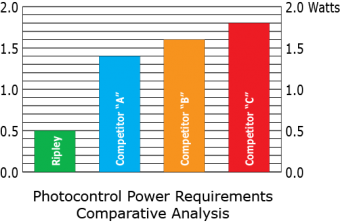Ripley 120 Volt photocontrols require less than 0.5 watts of power.
The big deal about photocontrol power requirements - Cost of Operation
The seemingly low level of power required for operating individual photocontrols becomes exceedingly significant when considering the large quantities generally required. Multiply the number of photocontrols by the power required for each, and the overall power requirements become obvious.
How Much? $$$
The cost of operating electrical loads is broken into two parts:
Energy Consumption - measured in Kilowatt-hours (KWH) and Electrical Demand (Connected Load) - measured in Kilowatts (KW)
Calculating the cost for Energy Consumption is straight forward, and is the sum of power requirements accumulated over time.
Calculating the costs associated with Electrical Demand can be much more complex. A demand charge is levied monthly based on the maximum average rate of energy consumption over a time period of measurement (typically 15 or 30 minutes). This time period of measurement is generally referred to as the Demand Interval. Additionally, many utility rates include provisions for assessing Peak Demand charges based on the single highest Demand Interval occurring during summer months, that can substantially affect utility bills for the month of occurrence, and each of the following eleven months. A review of local utility rates will reveal the impact for each individual case.
Photocontrols are Not Created Equal
In a recent study Ripley engineers tested the power requirements of individual off-the-shelf 120 volt photocontrols manufactured by Ripley and three competitors.
Testing results were as follows:
- Ripley 0.5 watts
- Competitor “A” 1.4 watts
- Competitor “B” 1.6 watts
- Competitor “C” 1.8 watts
